This resource guide discusses strategies for decommissioning solar energy operations. The guide includes details on extending performance periods, planning for decommissioning, cost examples and financial assurance mechanisms.
This resource guide discusses strategies for decommissioning solar energy operations. The guide includes details on extending performance periods, planning for decommissioning, cost examples and financial assurance mechanisms.
AgriSolar Clearinghouse partner Rob Davis has generously offered a full Solar Farm Lego set as a prize for the winner of the competition for best photo taken at one of the Follow the Sun tour field trips.
This set is priceless and can not be purchased. If you support the idea of a real-life Lego set being commercially available, vote here: LEGO IDEAS – Solar Farm. For a great background on the kit, see this NREL blog.
Please post your Follow the Sun photos to our forum here, or tag us on social media by using the hashtag #AgriSolar.
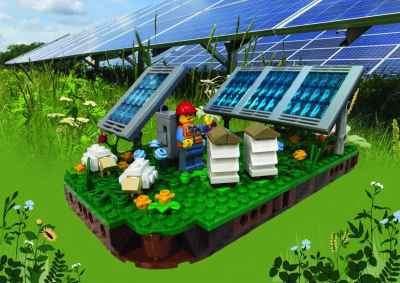
Solar Farm Lego Set. Photo: Rob Davis
The Follow the Sun Tour launched in Arizona, at Biosphere 2 and the Manzo Elementary agrivoltaic research site, and it was a great educational, inspirational, and networking event. Next up, we will travel to Minnesota on August 4 to tour Enel North America’s Lake Pulaski agrisolar site, US Solar’s Big Lake agrisolar site, and Connexus Energy’s agrisolar site in Ramsey. We’ll end the day on a sweet note with an Enel-sponsored Solar Farm to Table™ event featuring foods grown or pollinated at agrisolar sites. Get your free tickets here: Events – AgriSolar Clearinghouse.
The next week, we’ll travel to Massachusetts for a tour of the University of Massachusetts South Deerfield agrisolar research site and then the Million Little Sunbeams solar and hay farm, capping off the day at Knowlton Farms. Get your free tickets here: Events – AgriSolar Clearinghouse
In September, we will join forces with Jack’s Solar Garden, Sprout City Farms, and our partners at NREL and University of Arizona to tour Jack’s Solar Garden during its annual Night on the Farm. Stay tuned for details.
Over the next year, we’re planning more field trips to central California, Texas, Oregon, Virginia, Idaho, New York, and many more sites. If you have a site you’d like to highlight with an AgriSolar Clearinghouse fieldtrip, we’d love to hear from you. We’re looking forward to seeing you on the road!
GivePower Desalinates Water Overseas Using Aquavoltaics
“Austin, Texas-based GivePower started by installing solar panels for schools, community centers or other projects in communities in need. But GivePower founder Hayes Bernard realized that people, especially women and girls, would not attend school if they had to walk 8 miles to get water every day. That’s when the idea to include water pumps and desalination came to mind.
GivePower has seven operational desalination sites in countries like Haiti, Kenya, and Colombia. Four additional solar water farms are expected to become operational by the end of this year. GivePower has different sized desalination sites and setups. The largest one, the Solar Water Farm Max, produces up to 18,500 gallons of water daily — enough to support 35,000 people. It has a solar structure that acts like a roof over the water tanks and the twenty-foot equivalent unit shipping containers that house the desalination technology.” – American Shipper
Resource Guide for Decommissioning Solar Energy Systems
A new resource guide on decommissioning solar energy systems, written by AgriSolar Clearinghouse partner Heidi Kolbeck-Urlacher, offers resources for understanding solar project end-of-lifecycle management and recommendations for local governments to consider when drafting decommissioning ordinances. The report is now available through the Center for Rural Affairs here.
“Solar projects are often located in rural areas and can provide numerous benefits to nearby communities, including lease payments to landowners, tax revenue to fund infrastructure and services, and the creation of both permanent and temporary jobs. County officials are typically responsible for enacting siting or zoning standards to help ensure solar development is supported by local residents. This can include planning for the eventual decommissioning of energy projects that have reached the end of their life cycles.” – Center for Rural Affairs
The guide includes examples of decommissioning costs, extending performance periods of solar systems, recycling and disposal of solar panels, sample task lists associated with decommissioning solar systems, and recommendations for plans that define obligations of developers during the decommissioning process.
Chinese Fishery Deploys 70MW Solar Plant
“Farms where fish and algae thrive under solar panels might have secured their place in a future powered by renewable energy. Concord New Energy, a Chinese company that specializes in wind and solar power project development and operation, has installed a 70 MW solar plant atop a fishpond in an industrial park in Cangzhou, China’s Hebei region. The hybrid system integrates solar power generation with fishery in a unique way that not only saves land but also produces clean energy. This hybrid system is straightforward: a solar array is installed above the fish pond’s water surface, and the water area beneath the solar array is used for fish and shrimp farming.
The fishery-solar hybrid system is a type of floating solar farm that has grown in popularity over the years as solar power has evolved to meet the needs of our increasingly climactic times. For example, the United States has just begun construction of the country’s biggest floating solar farm in New Jersey.” – Interesting Engineering
Valley Irrigation Develops Solar Irrigation Site in Nebraska
Valley Irrigation has announced the completion of its first North American agrisolar installation in Nebraska through its partnership with Farmers National Company.
“The installation is located near Davenport, Nebraska, and will provide solar power to a Valley center pivot by offsetting energy consumption used to irrigate the field. Farmers National Company’s landowner client invested in Tier 1 solar panels, which are the highest-quality panels and are also used on major utility-sized installations. They are built to withstand the often-harsh conditions of Nebraska weather, including strong winds and hail.” – Valmont
“Matt Gunderson is with Farmers National Company and says it helps producers become more sustainable and increase return on investment. “We create some on farm generation not only to power a farm, but how do we tie it back into the grid system to support the electricity needs that are out there? And, along the way with it, sell that electricity back for some excess needs and create some investment opportunities and income generation for producers.” – Brownfield
By Emma Kampherbeek
Land is limited. Agriculture, electricity production, housing, nature, etc. all compete for the same plot of land. In some areas more than in others, but the competition is everywhere. On top of that, greenhouse gas emissions keep increasing and the global temperature keeps rising, leading to more frequent natural disasters and parts of the earth becoming uninhabitable. We shouldn’t only focus on stopping the global temperature from rising, but also on climate change adaptation and multifunctional land use now that ‘good’ land is getting scarcer.
It makes sense to have at least dual land use, but preferably use land for three, four or even more purposes. Agriculture and electricity production are a really good fit that can create win-win situations. That’s why I researched what I like to call ‘Solar Sheep’ – sheep that perform vegetation management on solar farms.
A lot of research is currently being done on the impacts of solar farms on soil health and biodiversity of flora and fauna. But what about sheep? Sheep are very effective grazers, which means that they are perfect for vegetation management on solar farms. Unlike goats, sheep don’t jump on the panels and don’t chew the wires. Unlike cattle, they are not heavy and large, which means that they can easily graze under the panels. They are also great with different types of terrain, like steep, rocky hills, which are hard to navigate for (robotic) mowers. These are a few of the advantages of sheep for solar farm owners.
How about advantages for the sheep? Is it also a positive experience for them to graze under solar panels? As many farmers who use their sheep for vegetation management on solar farms can tell you, sheep really don’t seem to mind grazing under and between the solar panels. This is also what my research showed, which was conducted on Gold Tree Solar Farm in San Luis Obispo, CA, in January 2021. Sheep on the solar farm grazed more than sheep in the natural rangeland without solar panels (see Figure 1). The solar panels provide shade and protection to the sheep. This prevents them from experiencing heat stress and protects them from harsh weather conditions, which will happen more frequently in the face of climate change. I live in the Netherlands, so heat stress didn’t use to be a big issue here, but in the last decade cases and mortality of heat stress have increased significantly.
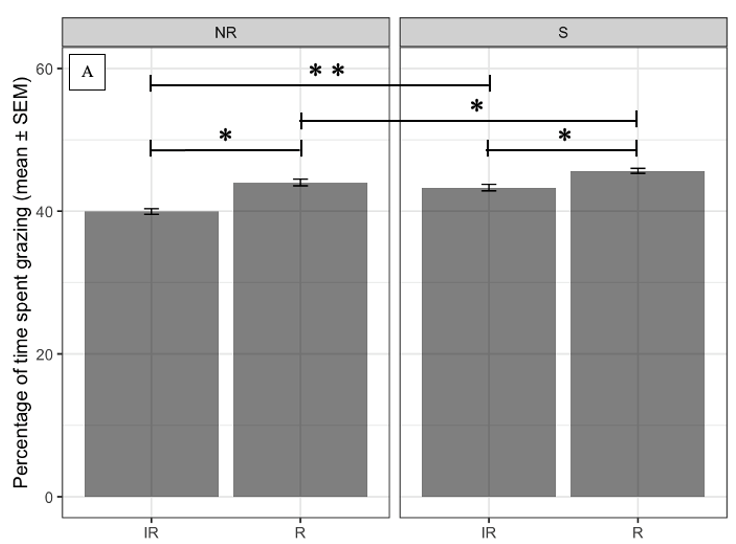
Figure 1 Bar graphs showing the mean (± SEM) of the total percentage of time spent grazing during the Main study over the total period of sixteen days of both treatment groups (NR & S) and both management types (R & IR).
* P < 0.0001, ** P = 0.0015, *** P = 0.031. (S = Solar; NR = Native Rangeland; R = Rotational; IR = Intensive Rotational).
The article is now under peer review but will hopefully be published later this year in the Journal of Applied Animal Behaviour Science as an open-access article.
Aquavoltaics to be Developed in Taiwan by 2023
“UK solar specialist Lightsource is developing a 150 MW solar park at a fishery in Budai, in Taiwan’s Chiayi County. Construction is expected to commence in June 2023. The company is co-developing the project with Germany’s Green Rock Energy. They plan to start construction on the facility in June 2023. Lightsource said the project will be one of the largest fishery solar farms in Taiwan and will be able to generate 210,000 MWh per year.” – PV Magazine Global
Farmers Could Become Energy Exporters in Italy
“Italy wants the European Union to allow farmers to sell surplus electricity they generate on their land, a measure that could help soften a bloc-wide energy crunch. “Italian agricultural companies have huge surfaces available that should be filled with solar panels,” Agriculture Minister Stefano Patuanelli said in an interview Monday, referring to the roofs of stables, granaries and sheds.
Solar sharing – which involves using farmland for producing crops as well as generating power – has gained traction in recent years, as farmers have sought to cash in on a renewable project boom. It is also not uncommon for them to lease their land and be paid indirectly, without owning the project.” – Bloomberg
National Pollinator Week Recognized
“Agriculture Secretary Tom Vilsack issued a United States Department of Agriculture (USDA) proclamation in recognition and support of National Pollinator Week (June 20-26, 2022). Pollinator species, such as bees, other insects, birds, and bats play a critical role in producing more than 100 crops grown in the United States. Honeybee pollination alone adds more than $18 billion in value to agricultural crops annually. USDA recognizes the critical role pollinators play in agriculture and supports pollinator health through research, data collection, diagnostic services, monitoring, pollinator habitat enhancement programs and pollinator health investments.” – USDA
The Knowlton Farm, a Massachusetts agrisolar operation, has recently partnered with BlueWave Solar to expand agrisolar operations on the farm in Grafton, according to an article by The New York Times.
Owner Paul Knowlton stated that the farm typically produces a variety of vegetables, dairy products, and hay, but also produces solar energy. He said that solar was already part of the farming operations, providing electricity for both his barn and home, but through this partnership with BlueWave, the farm will include a parcel of land where solar panels will share space with crops, known as dual-use solar, according to the report.
The dual-use solar operation includes adjusting the heights of solar panels to allow farm operations, including workers, equipment, and grazing animals, to operate underneath them. Spacing and angles of the solar panels are adjusted to benefit crops growing below them—shielding them from the elements, including intense heat. Some of the panels will have cattle grazing beneath them while others will grow butternut squash and lettuce.
The AgriSolar Clearinghouse will be touring the Knowlton Farm on August 10, 2022, as part of the Follow the Sun Tour. The tour is a series of hands-on field trips to see firsthand the benefits of co-locating sustainable agriculture and solar energy. Other locations on the tour include the Massachusetts Amherst South Deerfield research site and the Million Little Sunbeams family farm.
Pollinator-Friendly Solar in Plains, Georgia: A former U.S. president’s clean energy legacy

Sunset with Gaillardia and Solar Array. Photo: Jill Stuckey
With clean energy developments continuing to ramp up across the United States, more attention is being paid toward how best to develop these projects at the pace and scale that the climate crisis requires while also ensuring that we are taking care of the sites and communities that host those projects. That’s where a national project from the National Renewable Energy Laboratory (NREL), Great Plains Institute (GPI), Fresh Energy, and the University of Minnesota comes in. Funded by the U.S. Department of Energy’s (DOE) Solar Energy Technology Office, the Photovoltaic Stormwater Management Research and Testing (PV-SMaRT) project is using five existing ground-mounted photovoltaic (PV) solar sites across the United States to study stormwater infiltration and runoff at solar farms.
Together, the five sites represent a range of slopes, soil types, geographical locations, and PV configurations that will help solar developers and owners, utility companies, communities, and clean energy and climate advocates better understand how best to support solar projects and the host communities in which they are built, lowering the costs of clean energy development while ensuring protection of the host community’s surface and ground waters.
An early introduction to clean energy advocacy
Former President Jimmy Carter was an early advocate for clean energy development across the United States, from the West Wing of the White House to pockets of rural America, like his hometown of Plains, Georgia. Today, seven acres of a 25-acre parcel of former President Carter’s land, where peanuts and soybeans used to grow, is now home to a solar farm that can power more than half of Plains, a city of around 640 people. Situated in the middle of what is now a neighborhood, the project began when solar developer SolAmerica Energy approached the former President’s family about the possibility of installing panels on the land. That solar site now feeds into Georgia Power’s grid and is helping restore pollinator habitat, a well-known priority for former First Lady Rosalynn Carter, who helped create the Rosalynn Carter Butterfly Trail.
A flat site with sandy clay soil, Carter Farms hosts 3,852 solar panels to provide 1.3 megawatts of electricity to the Plains community via tracking, one-in-portrait arrays. As shown in Figure 1, the site is testing three separate seed mixes to monitor how the various ground cover intersects with stormwater management:
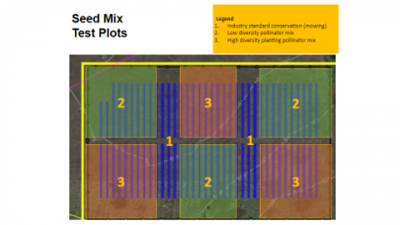
Figure 1. A map of the seed mixes on six different plots at the Carter Farms solar site in Plains, Georgia. Graphict: Aaron Hanson
Since the site was first built to accommodate the solar industry standard of planting some sort of grass underneath the panels, which requires more frequent mowing, the PV-SMaRT team and local partners are still monitoring the six different plots at the Carter Farms site to determine the full impact of the pollinator-friendly seed mixes. Bodie Pennisi, a professor of horticulture with the University of Georgia, reports that, so far, the dominant grasses in the control areas have been crabgrass, annual ryegrass, and panicum. “2022 is the year when we expect the strongest bloom from the perennial species, and we are really excited to see what pollinators and other beneficial insects come to the flowers.” Although the site plots are still being monitored, that hasn’t stopped researchers and other project participants from drawing initial conclusions and getting excited about the many benefits the pollinator mixes will bring for biodiversity, the climate, and SolAmerica’s site management costs. Figure 3 shows a morning bloom of black-eyed susans from the high-diversity pollinator mix.
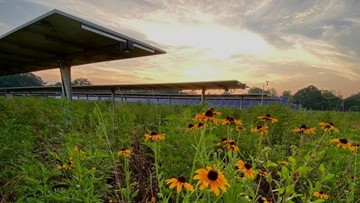
Figure 2. Blackeyed Susan flowers blooming at sunrise at the Carter Farms solar site. Photo: Jill Stuckey
Designing solar sites with extreme weather in mind
As discussed in Fresh Energy’s first PV-SMaRT case study on Connexus Energy’s Minnesota site, when engineers and researchers sit down to plan out or conduct analyses on clean energy developments like solar farms, they often utilize something called a design storm to test how well the site will hold up against an extreme weather event like a flood. A design storm is essentially a test flood event of a certain magnitude—the higher the magnitude, the more intense the test storm for modelling and analysis purposes. These tests help researchers and engineers monitor rainfall and soil moisture as well as determine how fast excess water soaks into the ground during extreme storms. Figure 3 shows the water monitoring equipment at the site.
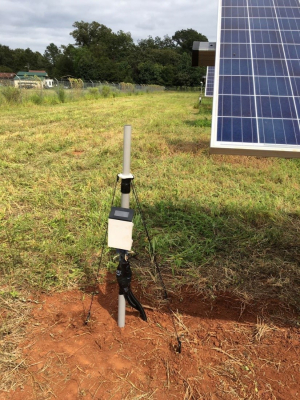
Figure 3. Water monitoring equipment sits at the west end of the Carter Farms solar site. Photo: Jake Galzki
Jake Galzki, a University of Minnesota researcher who is part of the modeling team for the PV-SMaRT project, says, “The Carter Farms site has a deeper profile than other sites we’ve studied – it’s a meter and a half to the nearest restrictive layer. That means the rooting depth for ground cover is deeper than other sites. And the soil at this site is essentially a 1:1 sandy clay, meaning it is comprised of 50 percent clay and 50 percent sand.” He adds, “In terms of measuring the runoff at Carter Farms against the other four project sites, the runoff here is moderate despite being the wettest site we’ve studied. We noted good infiltration capacity when testing the 100-year design storm, but we also did see some runoff due to the high clay content of the soil, which is very typical during such extreme events.”
Aaron Hanson, energy program specialist at the University of Minnesota’s Institute on the Environment, says: “It’s great that we have such diversity among our research sites. The climate and soil conditions in southern Georgia are quite different from what we are used to in Minnesota. The ‘growing season’ is actually reversed. Rather than having snow cover in the winter, they have a dormant period during the heat of the summer. This diversity of research site conditions will ultimately help our model to be applicable for solar developments across the country.”
Craig Kvien, one member of the Georgia-based site management crew, is an agricultural specialist whose expertise with innovative solar and agricultural projects runs decades deep. Craig says that the process for tending to the plots has come with its challenges, namely weeds. “We’ve got a team of people who’ve been sampling and documenting the plant and insect species that are out there over time, including the ones we anticipated, and those we did not,” Craig says with a chuckle. He adds, “Part of the process for ensuring the pollinator mixes can thrive requires a good amount of effort to beat down the weeds that also want to grow.”
But Craig isn’t daunted by what he calls a “standard mix of hard-to-get-rid-of weeds, which includes briars.” When asked what it is about the project that excites him the most, he doesn’t hesitate to remark on the beauty of a multi-use property: “There are lots of options. It seems silly not to do something useful with the land underneath the solar panels, particularly if you can make a difference somehow, either by enhancing the pollinator species in the area—or making or saving an extra buck.”
Science reflected in the practice
Brian Ross, vice president of renewable energy at Great Plains Institute and project lead for PV-SMaRT, says, “This site in Georgia helps bring both scientific validity to the modeling and runoff coefficients, adding diversity of soil types, hydrology, and land use, but also to develop regulatory, permitting, and project best practices that flow from the science.” He adds, “Georgia regulators have been participating in these discussions and helping ensure that the science is ultimately reflected in the practice.”
John Buffington, vice president of SolAmerica Energy, says the pollinator piece was a key consideration for the company. “SolAmerica was originally motivated by the opportunity to contribute to the restoration of pollinator habitats,” John says. “We think supporting these initiatives is the right thing to do and gives us an opportunity to be a more engaged member of the communities in which our solar developments are located. Later, we were excited to hear about the stormwater and cost-management aspects of pollinator-friendly solar.”
According to John and the SolAmerica team, pollinator-friendly solar has the potential to change the whole solar industry. “We could have done a pollinator project and just been quiet about it,” he admits. “But that wasn’t the intent, because we were trying to inspire the industry, and the Carter site was a great vehicle for that. These pollinator-friendly and stormwater supporting practices help contribute to better management of a site by reducing the amount of our budget that goes to mowing and other maintenance. So, beyond the pollinator restoration aspect, there are clear business benefits to doing this with a solar site.”
Ongoing stakeholder feedback
Like the other PV-SMaRT sites, data and observations from the Carter Farms site now serve as a benchmark as the PV-SMaRT research team continues to gather insight about each of the five project sites across the country. Overall, ongoing findings at the Carter Farms site further validate the project’s recommended best practices for solar developments and stormwater management: We can help lower the soft cost of clean energy development and of ongoing maintenance, protect the host community’s surface and ground waters, create needed habitat, and sequester carbon in the soil, all while helping craft a truly sustainable clean energy future that will benefit everyone for generations to come—just as the Carters have long worked towards.
Throughout 2022, experts and stakeholders will be reconvening in this process to continue to examine and provide feedback on this foundational research. Read the first PV-SMaRT case study on Connexus Energy’s Minnesota site, get the latest updates from Great Plains Institute, and stay tuned for the third and final PV-SMaRT case study from Fresh Energy and partners.
A version of this article was originally published via Fresh Energy. Read it here.
US Solar and T-Mobile have partnered on 14 Solar Community Gardens in Minnesota. T-Mobile’s sunscription to US Solar’s Community Solar Garden means the company will benefit from local solar without upfront costs and equipment. The energy-cost savings will apply to seven Minnesota counties.
Erica Forsman, Vice President of Origination at US Solar, stated, “We’re focused on providing solutions to our commercial partners that make it simple and beneficial to support local clean energy. We are excited to partner with T-Mobile and provide a renewable energy solution to support their industry-leading sustainability goals in Minnesota and across the nation,” according to Businesswire.
US Solar also partners with Excel Energy, not only operate over 120MW of renewable energy to their grid but has implemented AgriSolar operations by planting pollinator-friendly vegetation on those sites. This pollinator-friendly vegetation on solar sites reduces stormwater runoff, enhances soil regeneration, and increases air quality in surrounding communities.
Three of the Minnesota Community Solar Gardens began operation in late 2021, and the other 11 are in various stages of development and construction. In early 2021, T-Mobile became the first telecom to achieve their RE100 commitment to source 100% of their electric usage from renewable energy.
Learn more here.
This paper shows that agrivoltaic systems allow us to reach sustainable food and electricity goals with high land-use efficiency. The study shows the yield, antioxidant capacity, and secondary metabolite of broccoli and electricity production were analyzed under an agrivoltaic system over three cultivation periods. The study also reports that agrivoltaic with additional shading treatment produced greener broccoli with a higher level of consumer preference than open-field grown ones.
American Farmland Trust Announces Guidebook and Workshops for Solar Leasing
American Farmland Trust, a stakeholder in the AgriSolar Clearinghouse, has announced they will offer virtual and in-person workshops designed to help ranchland and farmland owners understand the emerging solar-development field.
“Solar energy development is accelerating rapidly in our region, and what we’re seeing is that farmland and rangeland owners are on the frontlines of this trend,” says Addie Candib, AFT Pacific Northwest Regional Director. “Many communities are wrestling with the question of whether – and where – solar should be built, but at some point, it will be up to the individual landowner to decide what’s in the long-term best interests for their business and their families. That’s what this project is about – helping farmers and ranchers to make informed decisions about the future of their land.” – American Farmland Trust
Pair of Community Solar Bills Passes in Maryland
“The Maryland legislature has taken steps towards strengthening its ongoing community solar pilot program, passing a pair of bills targeted at increasing the amount of eligible projects, and increasing the incentive for such projects to be developed. HB 1039 and HB 440 create tax incentives for the development of agrivoltaic community solar projects which serve low- and moderate-income customers on rooftops, brownfields, landfills, and clean fills, as well as increasing maximum project capacity to 5 MW. The bills both build on regulatory action from 2021, which expanded the program to allow community solar to power the equivalent of an additional 6,840 Maryland homes, while also allowing community solar projects to be built on clean-fill construction sites, transforming previously unusable industrial locations into clean solar energy generation sites.” – PV Magazine
Australian Solar Park will Host Crops in New AgriSolar Program
“Italy’s Enel will launch an experimental agrivoltaics program at its 34 MW Cohuna Solar Farm in the Australian state of Victoria to help formulate a ‘best practices’ template for utility-scale solar PV sites in other countries. Enel Green Power Australia, a subsidiary of Italian energy giant Enel, will explore how to combine solar PV generation and agricultural production in a new research program to be undertaken at its Cohuna Solar Farm in northern Victoria. Much of the land near the Cohuna Solar Farm is home to sheep grazing operations. While ‘solar grazing’ is proving to be a popular form of land co-use for large-scale solar, other forms of agrivoltaics are emerging that support horticulture, viticulture, aquaculture and even cropping activities.” – PV Magazine